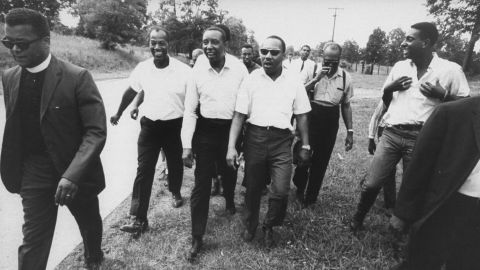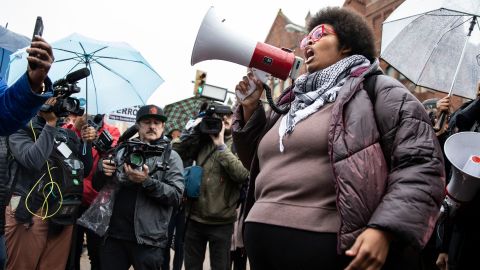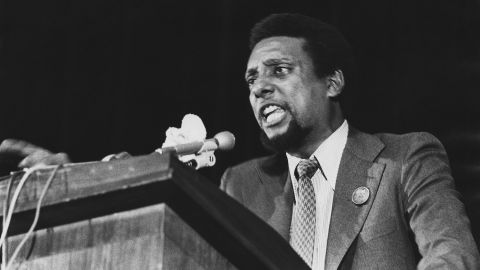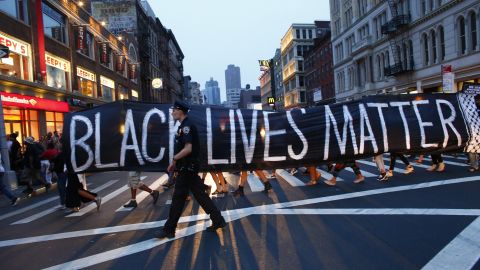Editor’s Note: Mark Whitaker is the author of the forthcoming book “Saying It Loud: 1966 –The Year Black Power Challenged the Civil Rights Movement,” along with “My Long Trip Home” and “Smoketown: The Untold Story of the Other Great Black Renaissance.” He is the former managing editor of CNN Worldwide, Washington bureau chief for NBC News and Editor of Newsweek. The views expressed here are his own. Read more opinion on CNN.
CNN
—
Like so many other turning points in Black history, it started with a police incident.
In the summer of 1966, America’s top civil rights leaders had descended on Mississippi for what became known as the Meredith March. They were making their way from Memphis, Tennessee to Jackson, Mississippi to carry on a solo voting rights march begun by James Meredith, the Black activist who had integrated the University of Mississippi three years earlier. Meredith had been shot by a White supremacist and hospitalized with severe bullet wounds.
When the march reached Greenwood, Mississippi, Stokely Carmichael, the recently named chairman of the Student Nonviolent Coordinating Committee (SNCC), got permission from a local Black school to erect sleeping tents on its grounds. But as he was helping to put up the tents, he was arrested by the local White police chief, known as “Buff” Hammond, and dragged to the local jail.
As Carmichael awaited bail that afternoon, he counted the number of times —27—that he had been imprisoned in the South since joining SNCC as a Howard University undergraduate. By the time he was released, he was primed to adopt a defiant new slogan that a SNCC comrade, Willie Ricks, had been testing in small churches along the route.

Some 500 marchers and local youth had gathered on the dusty baseball field for a nighttime rally, and as Carmichael climbed onto the back of a truck with generator-powered lights below, he looked as though he had stepped onto a floodlit stage. “We’ve been saying ‘Freedom Now’ for six years and we ain’t got nothing,” Carmichael shouted. “What we’re going to start saying now is ‘Black Power’!”
“Black Power!” the crowd shouted back. “We want Black Power!” Carmichael cried again, five times in all. “Black Power!” the crowd screamed back each time.
The next day, a short Associated Press story describing the scene was picked up by more than 200 newspapers across America. Overnight, the Black Power Movement was born.
As Black History Month begins, we are witnessing a resurgence of Black Lives Matter protests and calls for police and other reforms in the wake of the fatal police beating of 29-year-old Tyre Nichols in Memphis. But as I discovered in reporting a book on the birth of the Black Power Movement, the roots of much of what is happening in American race relations today trace back to that pivotal year of 1966.

From the start, the media assumed the worst about the Black Power slogan. Was Carmichael calling for “taking power by force and violence—by the overthrow?” Martin Agronsky, the host of Face the Nation, prodded when Carmichael was booked for his first national TV appearance three days after the Greenwood speech.
In fact, the initial aims of the Black Power Movement born in 1966 were relatively modest—and represented attempts by an impatient generation of Black youth to address systemic problems that persisted even after the legislative gains won by Dr. Martin Luther King Jr. and previous Black leaders.
Despite the passage of the 1965 Voting Rights Act, Carmichael recognized that registration alone wouldn’t be enough to protect poor Blacks in the Deep South, where police allowed the Ku Klux Klan to terrorize with impunity. So he had spent the previous year organizing Blacks in backwater Lowndes County, Alabama to form a new independent political party that could elect candidates for sheriff and other local offices, with a panther symbol that would be recognized by poor sharecroppers who couldn’t read.
In the fall of 1966, two part-time Black community college students in Oakland, California borrowed that same striking logo to create the Black Panther Party for Self-Defense. Although Huey Newton and Bobby Seale drafted a sweeping list of demands they called the “Ten Point Program,” they also were focused primarily on the issue of police violence in Black communities.
When the Panthers first donned their famous leather jackets and berets and posed with rifles and handguns, it was to advertise their plan to take advantage of California’s “open carry” gun laws to create armed civilian patrols to monitor the Oakland police.
As if to prove the Panthers’ point, however, the summer of 1966 brought a series of clashes between police and urban Blacks that set off riots in Chicago, Atlanta and the San Francisco neighborhood of Hunters Point. In the mind of the White public, those uprisings became conflated with the “Black Power” slogan and drove a sharp drop in White support for the entire civil rights agenda. In a Newsweek poll, Whites suddenly opposed even nonviolent Black protest by more than two-to-one.
When King tried to bring his peaceful playbook to Chicago, with a focus on housing, he encountered a White counterattack as vicious as anything he had witnessed in the South. In the 1966 midterms elections, a White “backlash vote” helped elect Ronald Reagan to the statehouse in California and propelled a rightward swing that set the stage for Richard Nixon’s law-and-order campaign two years later.
As this pattern of Black unrest and White backlash continued, the media caricature of Black Power gradually became a self-fulfilling prophesy. Carmichael grew more outrageous in his rhetoric, leading one New Yorker writer to wonder if he was just a “put-on” artist.
An ultranationalist faction within SNCC pushed to expel all White members, a bid that was initially dismissed by the group’s leaders but eventually prevailed at a staff retreat rife with drug use in the Catskill Mountains. A few months later, a spent Carmichael stepped down as SNCC’s chairman after only one year, giving way to a successor with even more inflammatory rhetoric and far less charm named H. Rap Brown.

Another vicious cycle consumed the Black Panthers. Winning release from prison in late 1966 with the backing of authors who admired the jailhouse essays he would publish in the book “Soul on Ice,” Eldridge Cleaver teamed up with Newton and Seale—then pushed the Panthers to depart from their focus on local police and embrace talk of armed revolution.
That, in turn, made them an inviting target for J. Edgar Hoover and the FBI, who launched a war of sabotage and dirty tricks aimed at preventing any of Panther leaders from emerging as a “messiah” who might rally young Blacks. Within two years, the party’s founders were all in jail or in exile, and in no position to serve as more than radical poster boys.
Yet for all their flaws and flame-outs, the Black Power generation proved to be prescient in their analysis of the flaws in urban policing and the limits of racial integration King preached. As children of the Great Migration, they knew all too well the heartbreak of Blacks who had left everything behind in the South in pursuit of a false promise of physical security, fair housing and job opportunities in the North.

For today’s Black Lives Matter activists and others, the political lesson of 1966 is to understand that defiant slogans and street protests aren’t enough to bring about lasting change. Clear messaging and policy objectives, internal unity and cross-racial alliances are also essential.
A second lesson is to be prepared for fierce backlash to any temporary progress. A student of 1966 would not have been surprised to see how swiftly the momentum for police and other reforms stalled after the last moment of “racial reckoning” in 2020, in the face of a concerted campaign to demonize “wokeness” and calls to “defund the police.”
Yet an ever-deeper legacy of Black Power goes beyond politics. The year 1966 also brought a cultural flowering of racial pride that could be shared and celebrated by Blacks of every class or educational background. This “Black Consciousness” became manifest in the spread of Afros and dashikis, in the first celebration of Kwanzaa, and in Black parents proudly giving their children names that marked their racial identity—like Breonna, or Tyre.
In 1966, the Black Power pioneers established the principle that all Black lives deserve to matter. “In our minds, what it really meant was Black empowerment,” recalls Vern Smith, a veteran Black journalist who was a student at San Francisco State, where the push for Black Studies began. “It seems quaint when you look back at it, but the sense of inferiority that had been pushed down on people for generations was just not thought about until that moment…If you are a 20- or 25-year-old Black person today and you call yourself Black or African-American, it seems just like the most natural thing in the world to do. I guess that’s a testament to the success that Black Power had in terms of making people not feel bad about themselves and to really embrace who they were.”